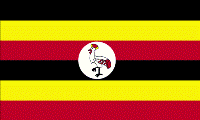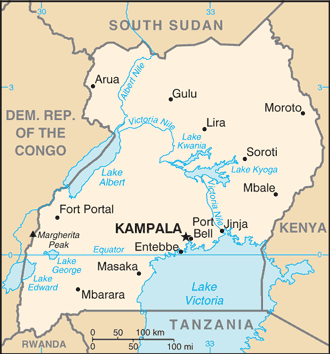Sep 24 2012
Topics Covered
Welcome to Uganda
Overview of Resources
Metals
Industrial Minerals
Fossil Fuels
Investment
Sources
Welcome to Uganda
Uganda is located in East-Central Africa with Kenya to the east and Democratic Republic of Congo to the west. The total area of the country is 241,038 km2, and it has a population of 33,640,833 as of July 2012. The country’s climate is predominantly tropical.
 |
The national flag of Uganda.
Image Credit: CIA Factbook. |
Since Uganda gained its independence in 1962, the country has witnessed a lot of bloodshed in the form of guerrilla war and human rights abuses caused by ruling political parties. However, since the late 1980s, the country has seen stability and economic growth. The country has been able to tide over the 2008-2009 downturn with sound management and reforms. The GDP of the country in 2011 was $46.96 billion.
Oil revenues and taxes have aided government funding to a certain extent in the past. However, the news of oil discoveries in 2006 could prove to be a great advantage to its economic progress. Experts believe that the oil sector will transform Uganda into a middle income country by 2030.
The natural resources of Uganda are abundant but poorly developed and include copper, cobalt, limestone, and salt. The country has several untapped reserves of lucrative minerals like gold, nickel, platinum, and marble. The majority of the mining and mineral processing units are privately owned.
Overview of Resources
The mineral and metal sector of Uganda is not a significant contributor to its economy. In 2010, Uganda produced cobalt, gold, iron ore, lead, niobium (columbium), steel, tantalum, tin, tungsten, beryl, gypsum, kaolin, clays, lime, salt, soapstone, vermiculite, cement, limestone, and pozzolanic materials in small quantities.

The map of Uganda. Image Credit: CIA Factbook
Metals
In 2010, Kasese Cobalt Company Ltd. (KCCL) produced refined cobalt from a stockpile. However, the production levels did not improve. From 673 t in 2009 it decreased to 624 Mt in 2010. Experts state that this stockpile is likely to be depleted by 2013.
Gold has been mined by artisanal miners in very small quantities. Land ownership disputes caused M/S Busitema Mining Company Ltd. to shut down its gold mine in 2010. Hence in 2009 and 2010, there were no official reports regarding any gold production. Uganda’s first gold refinery was opened by Victoria Gold Star Ltd. of Russia in 2010. The refinery is designed with a production capacity of 60 kg/d.
Industrial Minerals
Owning to the increase in domestic consumption of cement from 1.34 Mt in 2009 to 1.49 Mt in 2010, cement production in Uganda increased from 1.16 Mt in 2009 to 1.35 Mt in 2010. Reports state that the demand for cement is likely to double by 2017.
Tororo Cement Ltd. accounted for a major chunk of the nation’s total cement production. The company plans to increase its capacity to 2.2 million Mt/yr from 1 Mt/yr.
Hima Cement Ltd. completed its expansion project with the capacity increasing from 350,000 t/yr to 850,000 t/yr.
Vermiculite production was restarted in May 2010 by Gulf Industrials Ltd. of Australia at its Namekara Mine with plans to increase capacity to 35,000 t/yr from 15,000 t/yr by mid-2012. Further expansion plans have been scheduled to be completed by mid-2015 to increase the capacity to 100,000 t/yr.
Fossil Fuels
Currently, Uganda meets all its petroleum requirements via imports that are valued at about US$ 320 million per annum. The oil sector is gradually picking up pace ever since oil reserves have been discovered. There are 18 oil fields containing about 2.5 billion barrels of commercially viable oil reserves. Experts estimate that the oil discoveries made to date is sufficient to produce over 100,000 bbl/d for the next 25 years.
In 2010, Tullow Oil plc of Ireland drilled 10 natural gas and petroleum exploration wells on Blocks 1, 2, and 3A in the Lake Albert Basin. The company also plans on starting crude petroleum and natural gas productions.
In the same year, the Ugandan government also announced its plans to construct a new refinery at Hoima with a capacity ranging between 20,000 and 25,000 bbl/d to meet local demand for petroleum products. Further expansion plans are slated from 2012 to 2016 to increase capacity to 200,000 bbl/d.
Investment
Uganda’s mineral industry has a great scope for growth in the near future with the government taking many measures to showcase its untapped mineral and metal wealth.
This October, Uganda will be hosting its first international mining conference organized by the Uganda Chamber of Mines and Petroleum (UCMP) to attract investment. One of the key tasks of the UCMP is to link investors to government departments.
Earlier this year, the ministry of Finance inaugurated the Business Licensing Reform Committee to formulate and improve mining laws to attract investors. The ministry of Energy has worked towards gathering airborne geophysical survey data, which is now available for investors to aid in their decision making.
With the government keen on opening many regions to international mining operations, experts wonder about the fate of many tribes such as the Karamojong tribe, who rely on small scraps of gold they mine via shafts made in the ground. They work with primitive tools under harsh conditions to make a living. Many lives have been lost due to collapsed shafts or other safety risks. The government has not done much towards the development and security of such tribes.
Disclaimer: The Author of this article does not imply any investment recommendation and some content is speculative in nature. The Author is not affiliated in any way with any companies mentioned and all statistical information is publically available.
Sources